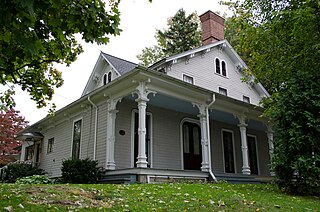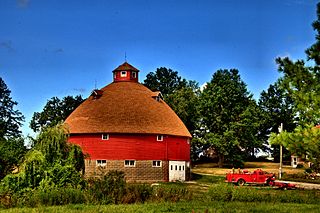
Horne Creek Farm is a historical farm near Pinnacle, Surry County, North Carolina. The farm is a North Carolina State Historic Site that belongs to the North Carolina Department of Natural and Cultural Resources, and it is operated to depict farm life in the northwest Piedmont area c. 1900. The historic site includes the late 19th century Hauser Farmhouse, which has been furnished to reflect the 1900-1910 era, along with other supporting structures. The farm raises animal breeds that were common in the early 20th century. The site also includes the Southern Heritage Apple Orchard, which preserves about 800 trees of about 400 heritage apple varieties. A visitor center includes exhibits, a gift shop and offices.

The John Brown Farm State Historic Site includes the home and final resting place of abolitionist John Brown (1800-1859). It is located on John Brown Road in North Elba, near Lake Placid, New York, where John Brown moved in 1849 to lead freed slaves in farming. It was declared a National Historic Landmark in 1998. It has been managed by the state since 1896; the grounds are open to the public on a year-round basis, and tours of the house are offered in the warmer months.
Johnson Farm may refer to:

The Harry S. Truman Farm Home, also known as the Solomon Young Farm, is a historic farm property at 12301 Blue Ridge Blvd in Grandview, Missouri. The farm property, first developed in the 1860s, was the residence of future U.S. president Harry S. Truman from 1906 to 1917. The house is part of Harry S. Truman National Historic Site, and is a designated National Historic Landmark.

The Martin House and Farm is a historic farm at 22 Stoney Hill Road in North Swansea, Massachusetts. The main house is a 1-1/2 story gambrel-roofed wood frame structure, with a crosswise ell at the rear. The oldest portion was built in 1728 by John Martin, as a single pile structure with a gable roof. It was soon afterward extended with a kitchen space, and was enlarged about 1814, when the gambrel roof was added. The property was farmed by Martin's descendants until 1934, when the property was bequested to The National Society of the Colonial Dames of America. The house is operated by the Dames as a historic house museum. It was listed on the National Register of Historic Places in 1978.

Greenwood, also known as Greenwood Heights, is a historic home located at Columbia, Missouri. It was built about 1839, and is a two-story, "T"-plan, Federal style red brick farmhouse on a stone foundation. It is one of the oldest remaining structures in Boone County, Missouri. Today the house is under private ownership.

Hildreth-Lord-Hawley Farm, also known as Pittsford Farms, is a historic home and farm complex located at Pittsford in Monroe County, New York. The 2 1⁄2-story, five-by-three-bay farmhouse was constructed in about 1814 and remodeled in the 1860s in the Italianate style. The property also includes a contributing dairy, creamery / ice house, tenant house, smoke house, blacksmith shop, and wagon shed. Contributing objects include a stone retaining wall with cast iron fence, stone fireplace, fountain, and cast iron statuary.

Johnson House is a historic home and farm complex located at Cape Vincent in Jefferson County, New York. The limestone farmhouse was built about 1840 and is a 1 1⁄2-story five-bay structure. Also on the property is a barn, a shed, and two corn cribs.

Greenmead Historical Park, also known as Greenmead Farms, is a 3.2-acre (1.3 ha) historic park located at 38125 Base Line Rd., Livonia, Michigan. It includes the 1841 Greek Revival Simmons House, six other structures contributing to the historic nature of the property, and additional buildings moved from other locations. Greenmead Farms was designated a Michigan State Historic Site in 1971 and listed on the National Register of Historic Places in 1972.

Applethorpe Farm is a historic farmstead in northeastern Ross County, Ohio, United States. Located along Whissler Road north of the unincorporated community of Hallsville, it was established by the family of John Buchwalter in the early years of the nineteenth century. Among the region's earliest settlers, the Buchwalters erected a large log building soon after taking possession of the property. As the years passed, the farm acquired the name of "Applethorpe" because its grounds included the first apple orchard in Ross County.

The Bonde Farmhouse is a historic farmhouse located in Wheeling Township in Rice County, Minnesota, United States, approximately 1 mile (1.6 km) from Nerstrand. The private home was placed on the National Register of Historic Places (NRHP) on April 6, 1982. The farmhouse is significant both for its association with a prominent Norwegian immigrant family as well as its local limestone construction and outstanding integrity.

Oliver Johnson's Woods is a historic district and neighborhood on the northern side of Indianapolis, Indiana, United States. Located in southern Washington Township, the district occupies the site of what was once the family farm of Oliver Johnson. Born on the present site of the Indiana State Fairgrounds, Johnson grew up in a pioneer family that lived on the edge of the state capital city. Upon attaining adulthood, he bought property a short distance to the west, to which he moved in 1846. Here, he built a larger farmhouse in 1862, and he tilled the soil for most of the rest of his life. As Indianapolis grew northward, it reached the Johnson farm in the early twentieth century; the aged farmer and his sons saw the city's growth as an opportunity for financial gain, and in 1905 they announced the platting of 0.25 square miles (0.65 km2) of their property into individual lots. They chose an advantageous time to sell their property; as the new residents began to build their homes, an interurban railway was built along College Avenue on the district's western side that connected downtown with Broad Ripple. Many prosperous businessmen were attracted by the development's large lots and wooded streets; the city annexed Oliver Johnson's Woods in 1912, and by the outbreak of World War II, the streets were filled with large houses built in a wide variety of architectural styles. These early residents came from many different ethnicities: European immigrants were becoming more prosperous and leaving their ethnic enclaves, and new neighborhoods such as Oliver Johnson's Woods appealed to them. Among the neighborhood's leading residents was a colony of Jews of German descent.

The Hiram C. Smith House is a historic residence located west of Winterset, Iowa, United States. Smith was one of the earliest settlers in this township, having acquired the deed to the 280-acre (110 ha) farm between 1854 and 1856. This house is an early example of a vernacular limestone farmhouse. It is a 1½-story, one-room structure composed of rubble stone quarried on the farm and laid in a random bond. Its construction is attributed to Smith, as its rough and simple construction do not reflect the work of any of the stonemasons working in the county at the time it was built. The house was listed on the National Register of Historic Places in 1987. His milking shed, built about the same time and on the same property, is also listed on the National Register.

Orie J. Smith Black and White Stock Farm Historic District is a historic farm and national historic district located near Kirksville, Adair County, Missouri. The district encompasses six contributing buildings and one contributing structures on a farm about three miles northeast of Kirksville. It developed between 1910 and 1919, and features a round bank barn with a self-supporting dome roof, constructed in 1913. The other contributing resources in the district are the farmhouse, an American Foursquare with Prairie School affinities (1917), a granary (1910), a poultry house (1918) and two ice houses, and a concrete bridge (1914)

The Dan Johnson Farmstead is a historic farm property on United States Route 2 in Williston, Vermont. It was first developed in 1787 by Dan Johnson, one of Williston's first settlers, and has remained in his family since that time. The property includes three 19th-century houses and a large barn complex, as well as more than 200 acres (81 ha) of land crossed by US 2 and Interstate 89. It was listed on the National Register of Historic Places in 1993.

Garnett Farm Historic District, also known as Ott Farm, is a historic home and farm and national historic district located near Centertown, Cole County, Missouri. It encompasses 11 contributing buildings, 2 contributing sites, 2 contributing structures, and 1 contributing object dated between about 1860 and 1965. They include the farmhouse, garage, smokehouse, outhouse, well house, bull barn, bank barn, milk house (1952), cattle barn (1905-1906), tack room, grain bin, Garnett barn (1910), silo (1946); water pump, and a cemetery. The farmhouse is a two-story brick residence with some Georgian Revival and Italianate style features.

Gustav Grauer Farm, also known as the Maple Springs Farm and Creminscroft, is a historic home and farm located near Pacific, Franklin County, Missouri. The farmhouse was built about 1866 by German immigrants, and is a two-story, enclosed dogtrot log structure that was later clapboarded. Also on the property are the contributing barn, smokehouse spring house, and shed.

The Osage Farms Resettlement Properties in Pettis County, Missouri is a National Register of Historic Places multiple property submission located at Pettis County, Missouri. The submission includes 10 national historic districts and 2 individual properties listed on the National Register of Historic Places. The properties included were built by the Resettlement Administration / Farm Security Administration in 1937 as model farms and known as Osage Farms. Model farmsteads typically included a 1 1/2-story frame dwelling, barn, poultry house and privy.

Fuqua Farm is a historic farm property at 8700 Bethia Road in rural Chesterfield County, Virginia. The property, now about 23 acres (9.3 ha), was farmed by members of the Fuqua family from the 18th to the 21st century, and includes a vernacular 18th-century farmhouse. The farmhouse now includes elements of two structures that were joined together about 1905; in addition to the farmhouse there are also early 20th-century outbuildings, including a chicken house, garage, and shed.
Atkins House may refer to:



















